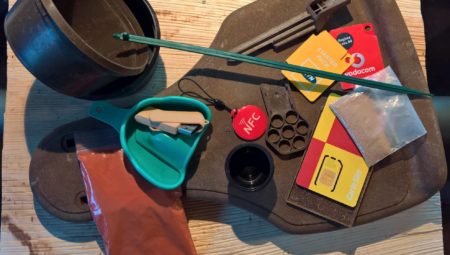The basic material is Bioframe, developed by the construction and infrastructure company BG&M. The material, made from jute fibres, PE and phenol resin, is pressed in an extrusion process into a sheet. A factory in India produces the Bioframe boards for the home market. There is also a market for Bioframe in the Netherlands, for example as duckboards, wall cladding or as components for cycle paths or pedestrian/cyclist bridges. Daan van Rooijen, on behalf of Stenden Hogeschool, is involved in the Interreg project Biobased Cycle Path (see box). ‘We see possibilities especially in applications which will benefit from the lower weight of our construction, for instance in swampy areas or for bicycle or pedestrian bridges.’
Heavy load
Broadly speaking, the biobased cycle path consists of three parts. First of all there is the substrate of rubble and clean sand. This is covered by a layer of extruded hollow sections based on wood fibres (editor’s note: 80 percent) and PP, produced by the German company Naftex. The Bioframe sections are then attached to the hollow sections. Van Rooijen: ‘On the test strip we are experimenting mainly with the top layer, which we have applied in different variations. Two have a foil, two have a coating and two have been roughened (editor’s note: sandpaper grit size 250). We are going to test how these surfaces behave in different weather conditions and under the load of users. The users are mainly people on bicycles and mopeds, but the surface and construction as a whole also have to cope with a 5-tonne gritting vehicle.’ The first finding is that the coating detaches quite fast. That only happens with extruded boards, according to Van Rooijen. ‘If the boards are pultruded, the adhesion of the foil to the PE layer is fine.’
Pultrusion
As pointed out by Van Rooijen, pultrusion is also included as production technique. Although this form of production is still (relatively) new for this specific application, pultrusion does offer a few advantages compared with extrusion, says Van Rooijen. ‘Shrinkage forms a considerable challenge with extrusion, definitely if these parts are used outdoors, in variable temperatures. This factor is less of an issue with pultrusion. Whatever the case, we have used sheets with a large surface area – 3 by 6 metres – to improve riding comfort. With smaller dimensions there is a greater risk of irregular riding surfaces.’ The sheets produced through pultrusion do cost more. But their lifespan is also longer, argues Van Rooijen. ‘You have to take the whole life cycle into consideration – from production, installation, maintenance through to end-of-life.’
Soft substrate
The end-of-life situation differs for the extruded and pultruded materials. The extruded sheets can be recycled via extrusion into new sheets for the same application. Pultruded sheets can only be downcycled into chipboard, but they do have a longer lifespan. Depending on this lifespan, ‘pultrusion sheets’ could actually represent the most sustainable route.
‘Apart from the differences, the two materials both have a significantly lower CO2 footprint than concrete or asphalt,’ according to Van Rooijen. ‘We are talking about five percent. The same applies to the lighting: the Bioframe poles are considerably more sustainable than aluminium poles.’
The comparison with concrete/asphalt is obvious. And yet the parties (see box) behind the cycle path do not have the ambition of replacing the former materials fully. ‘We see opportunities mainly for soft substrates such as woodland soil or bicycle and pedestrian bridges. There we can compete with hardwood, the use of which we want to cut back.’
End-of-life importance
The environment, that is, the CO2 footprint, is an important motive, certainly in view of the emission objectives under the Paris Climate Agreement. Now, a biobased cycle path will not immediately have much of an impact in this area. That is why the economic motive and the user convenience – for the road users and the parties responsible for maintenance – count heavily.
As indicated earlier, the costs are not purely material, production and installation. Maintenance and end-of-life are also factors which must be included. ‘Ultimately the new concept must become lighter, more efficient and more maintenance-friendly.’



